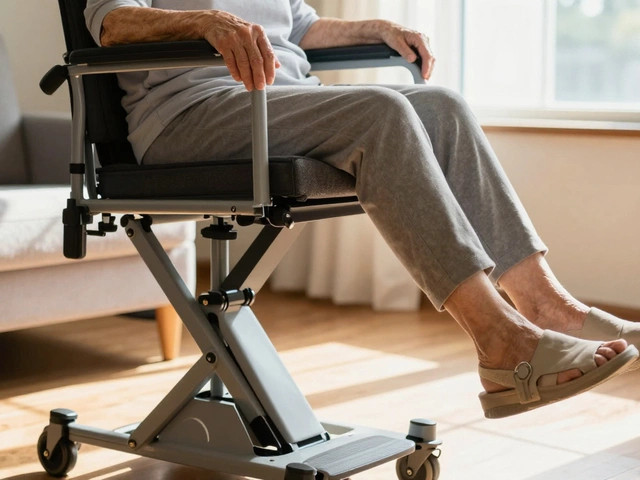Imagine struggling to stand up each time you sit. For some folks, it's a daily reality. That's where lift chairs come into play, turning dreaded challenges into manageable situations. But the million-dollar question is, can a doctor actually prescribe one of these chairs for you?
The short answer? Yes, they can. Doctors often write prescriptions for lift chairs when a medical need is obvious, say for people dealing with arthritis, severe back pain, or other mobility issues. It's not just about adding comfort—it's about improving quality of life.
But don't start shopping just yet. Understanding how this process works is key. Knowledge about insurance coverage, potential costs, and what models suit your needs is super important. So stick around as we unravel the facts on getting a lift chair through a doctor's prescription.
- Understanding Lift Chairs
- Medical Reasons for a Lift Chair
- Prescription Possibilities
- Insurance and Costs
- Choosing the Right Lift Chair
Understanding Lift Chairs
Alright, so what's the deal with lift chairs? These nifty seats are more than just comfy chairs. They come with a built-in motorized mechanism that tilts the base and back of the chair forward, helping you stand up with ease. Think of them as your personal standing-up assistant, tackling gravity one lift at a time!
You might see different types of lift chairs out there, generally categorized into three styles: 2-position, 3-position, and infinite position. The 2-position variety allows a slight recline, perfect for reading or watching TV. The 3-position offers a near-flat recline, good for napping. And the infinite position? It's like the luxury sedan of chairs, allowing you to adjust the back and footrest independently.
Now, why are these a big deal? Simple. For those with mobility challenges—like the elderly or folks with disabilities—stand-up/sit-down tasks can be daunting. That's where these chairs make a huge difference, offering not just comfort but independence too.
But before you jump into buying one, consider factors like size, weight capacity, and upholstery. You want a lift chair that fits your living space and lifestyle. And with plenty of styles out there, finding one that matches your decor isn’t too hard, either.
Here’s a quick tip: if you're exploring this option due to medical reasons, involve your doctor in the conversation. They can guide you not only in assessing your needs but also in navigating the possibility of getting a prescription.
Medical Reasons for a Lift Chair
Alright, so let's talk about why someone might need a lift chair. It's not just a fancy seat; it's a piece of equipment that can make daily life a whole lot easier for folks with specific health issues.
The most common reason for a doctor lift chair prescription is mobility challenges. Conditions like arthritis and severe joint pain can turn a simple act of getting up into a painful ordeal. Got knee or hip problems? A lift chair gently shifts you from sitting to standing—it’s like having a personal assistant built into your chair!
Another biggie is back problems. If you’ve got a herniated disc or persistent spinal issues, standing up can put extra strain on your back. A lift chair reduces that strain by helping you ease into a standing position without the usual twists and turns.
Now, think about those recovering from surgery or accidents. Sometimes the road to recovery is long and challenging. A medical recliner can offer the support and stability one needs during this time. It provides not only comfort but peace of mind.
And hey, if you've got balance issues, that's another reason doctors might suggest a lift chair. Falling is a genuine concern, especially for older adults, and a lift chair can help reduce that risk by providing stability during transitions.
Here’s a bit of a pro tip: If you’re considering getting a lift chair through insurance, having documentation of these medical reasons can be a huge help in getting that cover approved. It might even save you some bucks! Always talk to your doctor about the specific benefits you can expect based on your health needs.

Prescription Possibilities
If you're wondering if a doctor can write a prescription for a lift chair, the answer is a big yes! But, it's not as straightforward as filling a prescription for something like antibiotics. Lift chairs fall under the category of Durable Medical Equipment (DME), and obtaining them through insurance requires a bit of navigation.
To get a doctor lift chair prescription, you'll typically need a documented medical necessity. What does that mean? Well, if you have conditions such as arthritis or severe mobility impairments, your doctor may consider this chair essential for you. They assess your situation to see if a medical recliner could genuinely aid in your daily activities.
"A lift chair can be a game-changer for patients with mobility issues, providing both physical support and improving overall wellbeing," says Dr. Jane Mitchell, a leading physical therapist in elder care.
Once your doctor agrees that a lift chair is right for you, they'll provide a letter of medical necessity. This letter serves as the backbone of your claim when you're discussing coverage with your insurance provider.
- First, get evaluated by your doctor, emphasizing how a lift chair would assist in daily activities.
- Obtain a prescription and a letter of medical necessity.
- Submit these to your insurance provider.
- Check if the lift chair model you want is covered—sometimes they specify types.
Now, you might assume insurance covers everything, but that's not always the case. Depending on your insurance plan, they might cover part of the cost or none at all, leaving you to foot the rest of the bill. So, it's handy to know what's covered before making any serious decisions. A little prep work goes a long way in ensuring you have the right mobility aids without unexpected costs.
Insurance and Costs
You've got your doctor's prescription for a lift chair, but what about paying for it without breaking the bank? That's where insurance might save the day. If you're in Canada, provincial health coverage won't typically foot the bill. But don't lose hope just yet! Some private health insurance plans step in to cover costs, often under 'durable medical equipment.'
Here's where it gets real: understanding the terms. You'll want to check if your policy covers lift chairs and how much they’re willing to pay. And remember, not all plans are created equal. Some might only pay a portion or have specific requirements, like verifying your medical need.
For those leveraging insurance, there's probably an approval process. Keep your documents ready: doctor's orders, medical reports, and receipts. It speeds things up and helps with any paperwork hurdles.
Now, let’s talk dough. Lift chairs can vary widely in price depending on their features. Think anywhere from $400 for basic models to over $2,000 for high-end ones. Having insurance can ease the pain, but knowing what's covered matters.
- Know what's in your insurance plan.
- Get necessary documentation like prescriptions.
- Look for models that fall under coverage limits.
- Stay in touch with your insurer—ask questions and clarify doubts.
If you're going solo without insurance aid, consider talking to the retailer. Sometimes, they offer payment plans or discounts you wouldn’t expect. It might sound cliché, but knowing your options is half the battle in getting that lift chair into your living room stress-free!

Choosing the Right Lift Chair
Alright, you've got the go-ahead from your doc, and now you're in the market for the perfect lift chair. But hey, not all chairs are created equal, right? Knowing what to look for can make all the difference in comfort and usability.
First up, think about the chair's features. Lift chairs come in different medical recliner models like two-position, three-position, and infinite position. Basically, a two-position chair is good for upright and slight recline, while three-position offers a more laid-back lounge. The infinite position? Well, it lets you lie almost flat, which is a game-changer if you end up napping in it.
Now, size matters. This isn't a one-size-fits-all deal. The chair's dimensions should match your body to avoid any discomfort. A quick tip: when seated, your feet should touch the ground comfortably, and the back should support you well without being too snug or too far.
Consider your living space too. Measure the area where the chair will go to ensure it complements the room without creating zombie-like hurdles every time you walk by.
Next, look at the extras. Does it have a built-in massager or heating function? These can be heavenly for sore muscles. Oh, and don't ignore fabric types. Some come with stain-resistant materials, a lifesaver if you're a spill magnet.
Worried about costs? Check if your insurance covers any expenses. It might not cover the entire thing but could offset some cost, making your decision easier on the wallet.
If you want to go full tech-savvy, some lift chairs even come with USB ports, perfect for keeping your electronics charged without having to leave your cozy spot.
Here's a quick cheat sheet for choosing a lift chair:
- Type: Decide between two-position, three-position, or infinite.
- Size: Match it to your body for best comfort.
- Living Space: Measure your area for a good fit.
- Extras: Consider extras like massage, heat, or stain-resist materials.
- Insurance: Check coverage options to help with costs.







